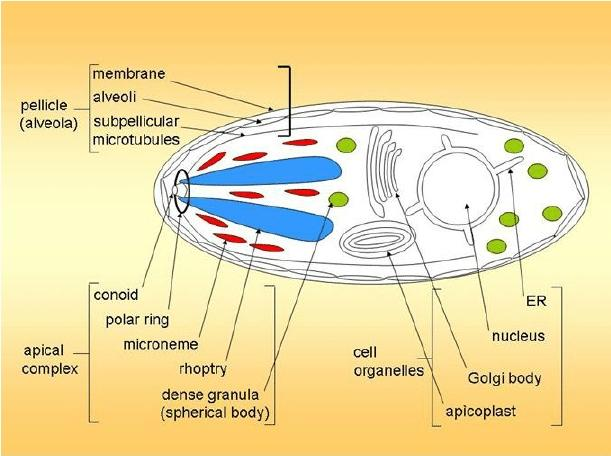Answer
414.9k+ views
Hint: Euglenoids are one of the best-known groups of flagellates, which are excavated eukaryotes of the phylum euglenophyte and their cell structure is typical of that group. They are commonly found in freshwater, especially when it is rich in organic materials, with a few marine and endosymbiotic members.
Many euglenids feed by phagocytosis, or strictly by diffusion.
Complete answer: The body of euglenoids are covered by a thin pellicle, that has oblique but parallelly arranged stripes. It provides the flexibility to cause temporary changes in body shape. The pellicle strips slide over one another to help in metabolic.
The pellicle gives some shape to the cell, especially during locomotion.
Pellicles of protozoan organisms vary from flexible and elastic to fairly rigid.
In ciliates and apicomplexan, the pellicle is supported by closely packed vesicles called alveoli.

In euglenids, it is formed from protein strips arranged spirally along the length of the body. Familiar examples of protists with a pellicle are the euglenoids and the ciliate paramecium.
In some protozoa, the pellicle hosts epibiotic bacteria that adhere to the surface by their fimbriae.
A monophyletic group consisting of the mixotrophic Rapaza Viridis (1 species) and the two groups Eutreptiales (24 species) and Euglenales (983 species) have chloroplast and produce their own food through photosynthesis.
This group is known to contain the carbohydrate paramylon.
So the correct answer is- D. Pellicle
Note: Unlike plants, fungi and most types of algae, protozoans do not typically have a rigid cell wall, but are usually enveloped by elastic structures of membranes that permit movement of the cell. In some protozoans, such as the ciliates and euglenozoans, the cell is supported by a composite membranous envelope called the "pellicle".
Many euglenids feed by phagocytosis, or strictly by diffusion.
Complete answer: The body of euglenoids are covered by a thin pellicle, that has oblique but parallelly arranged stripes. It provides the flexibility to cause temporary changes in body shape. The pellicle strips slide over one another to help in metabolic.
The pellicle gives some shape to the cell, especially during locomotion.
Pellicles of protozoan organisms vary from flexible and elastic to fairly rigid.
In ciliates and apicomplexan, the pellicle is supported by closely packed vesicles called alveoli.

In euglenids, it is formed from protein strips arranged spirally along the length of the body. Familiar examples of protists with a pellicle are the euglenoids and the ciliate paramecium.
In some protozoa, the pellicle hosts epibiotic bacteria that adhere to the surface by their fimbriae.
A monophyletic group consisting of the mixotrophic Rapaza Viridis (1 species) and the two groups Eutreptiales (24 species) and Euglenales (983 species) have chloroplast and produce their own food through photosynthesis.
This group is known to contain the carbohydrate paramylon.
So the correct answer is- D. Pellicle
Note: Unlike plants, fungi and most types of algae, protozoans do not typically have a rigid cell wall, but are usually enveloped by elastic structures of membranes that permit movement of the cell. In some protozoans, such as the ciliates and euglenozoans, the cell is supported by a composite membranous envelope called the "pellicle".
Recently Updated Pages
How many sigma and pi bonds are present in HCequiv class 11 chemistry CBSE

Why Are Noble Gases NonReactive class 11 chemistry CBSE

Let X and Y be the sets of all positive divisors of class 11 maths CBSE

Let x and y be 2 real numbers which satisfy the equations class 11 maths CBSE

Let x 4log 2sqrt 9k 1 + 7 and y dfrac132log 2sqrt5 class 11 maths CBSE

Let x22ax+b20 and x22bx+a20 be two equations Then the class 11 maths CBSE

Trending doubts
Fill the blanks with the suitable prepositions 1 The class 9 english CBSE

At which age domestication of animals started A Neolithic class 11 social science CBSE

Which are the Top 10 Largest Countries of the World?

Give 10 examples for herbs , shrubs , climbers , creepers

Difference between Prokaryotic cell and Eukaryotic class 11 biology CBSE

Difference Between Plant Cell and Animal Cell

Write a letter to the principal requesting him to grant class 10 english CBSE

Change the following sentences into negative and interrogative class 10 english CBSE

Fill in the blanks A 1 lakh ten thousand B 1 million class 9 maths CBSE



